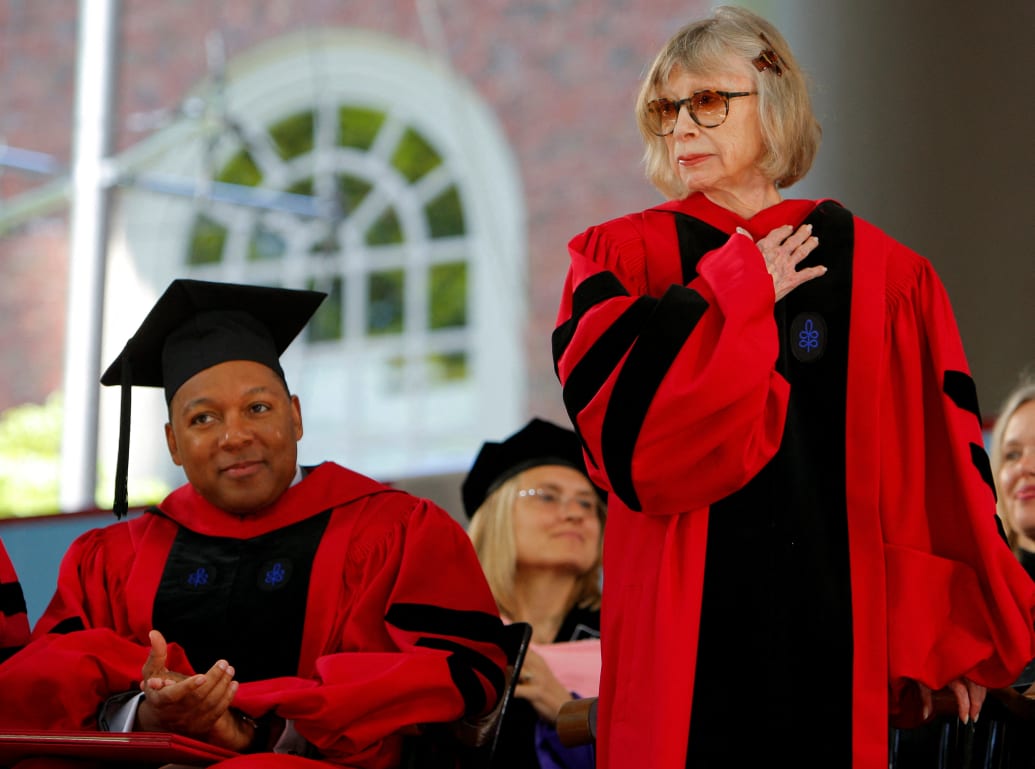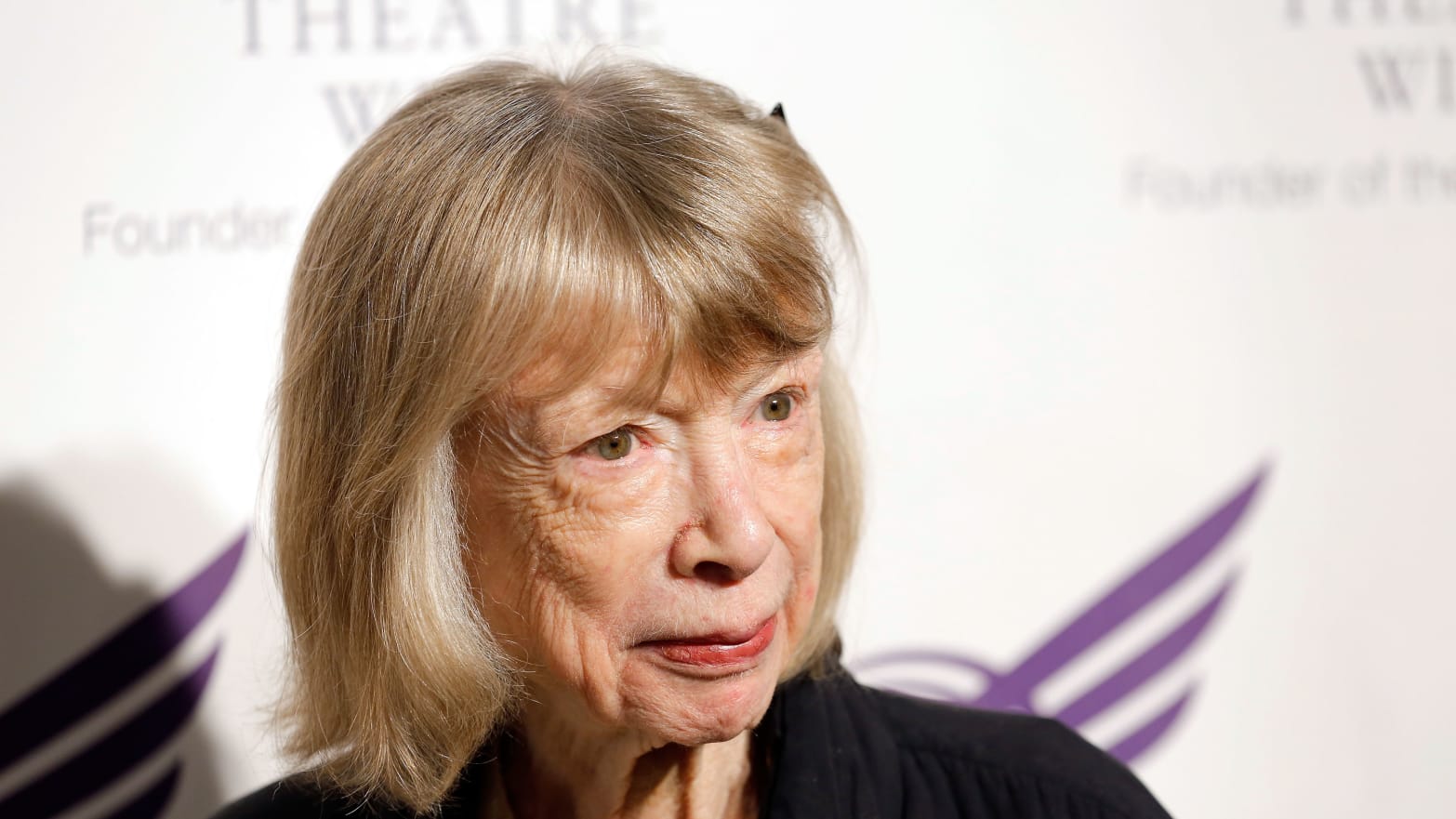Jemal Countess/Getty
Parenthood is messy. It’s fun, but fraught. Moments of abject clarity often precede colossal confusion and while some days are stimulating, others are soundly monotonous. But any parent will tell you that raising a human being is a game-changer, one that not only shifts the way we see ourselves, but also the way we see the world.
Joan Didion, the 87-year-old journalist and author who has died at her home in New York City from complications of Parkinson’s disease, knew that, too. A literary force, a sharp societal observer (and critic) and, arguably, one of the greatest essayists of all time, she was also a mother. Her life was rarefied. Her parenting—documented in her writing, marked by the insecurities and the joys that come with rearing a child—was familiar.
In a 2011 interview with Terry Gross on NPR’s Fresh Air, Didion spoke about how her drive to have a child turned up one day when she was in her twenties, and could not be ignored. After trying fruitlessly to conceive for several years with her husband, fellow writer John Gregory Dunne, the couple adopted a baby girl in 1966. They named her Quintana Roo. In a photograph of Didion and her infant taken around that time, the look on her face seems to say, “I can’t believe this child exists. What do we do with her now?” (As the mother of two sons, I can relate.)
Quintana died in 2005, at the age of 39, after an unorthodox string of medical issues that began with the flu. In Blue Nights, Didion’s 2012 meditation on grief and mortality written in the wake of her daughter’s death, she writes about the uncertainty and cluelessness of new parenthood. How, when Quintana arrived, Didion received 60 frothy dresses from exuberant friends and family, realizing only later the impracticality of the frocks and how much they cast her child as a little doll.
Or how the couple was prepared to embark on a work trip to Saigon the year Quintana arrived. Never thinking to call off the venture, Didion points out how she decided on things she would need for the trip (“Donald Brooks pastel linen dresses for myself; a flowered Porthault parasol to shade the baby”) with a casualness that belied what all parents know are the realities of traveling anywhere (even across town) with an infant.
Due to a deadline Dunne faced, and not a breakthrough about how to handle a baby, the trip never happened.
Didion was a working mother and had the pedigree and professional trajectory of a star. She worked at Vogue in the early days of her career. She was adventurous and smart, and wrote circles around her contemporaries (many male). She wore head scarves and big sunglasses. Photos of her from the ’60s and ’70s are glamorously unglamorous: standing amid mid-century modern furniture while coolly holding a cigarette, leaning on a sleek Stingray sports car, sitting with Quintana, the fingers of her left hand resting in the girl’s blond hair.
There were parties and celebrities and a ramshackle-chic life in Malibu, and Quintana was very much in it, a child of her parents’ profession. But motherhood can be a judgy place and Didion seemed to feel it. Despite becoming a mother during the beginnings of the women’s movement, Didion didn’t consider herself a trailblazer. “It never crossed my mind that I would have to figure it out,” she told Gross. “I always thought I would be working, and I always thought that I would have a baby, if I was lucky enough.”
Reconciling the two proved tricky. She writes about being away on work assignments during her daughter’s formative years and the associated guilt, the misgivings, the feelings of maternal failure. Or how it took her years to recognize Quintana’s struggles with alcoholism, depression, and borderline personality disorder. She often said that she wasn’t sure she had done a very good job. Quintana semi-agreed: “I think you were a good parent, but maybe a little remote,” she said, in an oft-mentioned quote.

Didion attends the funeral of Dominick Dunne, Aug. 26, 2009.
Rick Gershon/Getty
I got through Blue Nights in two days, after coming to Didion’s work on the late side. Reading her memorably turned phrases about missing her daughter—recalling everything from her childhood penmanship to the flash of her red-soled shoes on her wedding day—was challenging. My kids, 4 and 11 months at the time, seemed so new and infinite that a vision of them as fully formed people, with separate lives and inner compasses calibrated (in large part) by me and my husband, seemed impossible to conjure.
Dunne had died two years before Quintana; The Year of Magical Thinking, Didion’s book on that experience, came out in 2005. The quick succession of her losses, coupled with her observations and musings on the grieving process, as well as her own mortality, established Didion as a voice on grief, one trained on the monumental task of encapsulating how it feels (how it really feels) when a loved one dies.
But her writing, long before the losses, had often centered on motherhood, such as in the 1977 novel, in which a mother watches her daughter get caught up in all manner of trouble. In interviews, Didion often said that writing those types of characters helped her prepare for letting Quintana, as an adult, go out into the world.
Kids leave. Life happens. Parents worry—not only about said kids, but about their ability to shepherd them through.
“I do not know many parents who think they have succeeded as parents,” she writes in Blue Nights. “Those who do tend to cite the markers that indicate (their own) status in the world: the Stanford degree, the Harvard MBA, the summer with the white-shoe law firm. Those of us less inclined to compliment ourselves on our parenting skills, in other words most of us, recite rosaries of our failures, our neglects, our derelictions and delinquencies.”

Musician Wynton Marsalis applauds as author Joan Didion stands to receive an honorary Doctor of Letters degree at Harvard University on June 4, 2009.
Brian Snyder/Reuters
In the 2017 documentary Joan Didion: The Center Will Not Hold, Didion sits as her nephew, Griffin Dunne, interviews her. In one scene early on, while speaking about her days covering the Haight-Ashbury hippie scene in San Francisco, he asks her about a time when, while reporting a story, she witnessed a 5-year-old on an acid trip. What on Earth did she think when she saw that? She pauses for a beat before answering.
“Well, it was… Let me tell you, it was gold,” she said. “I mean, that’s the long and short of it is. You lived for moments like that if you’re doing a piece. Good or bad.”
It was not the answer I expected. But there was something thrilling about her honesty. It was the response of a journalist first. It was the response of a tenacious truth-seeker fueled by a quest for detail and the real story, often independent of emotion. It was the response of a woman who valued her career, her creative process, her professional autonomy—and still managed to raise a child. That experience may not have been perfect. But it was real.

